In the News
Understanding Value Added Tax
October 22, 2015

By: Dr. Robert F. van Brederode
Value Added Tax (VAT) is a growing source of revenue for governments, now levied in more than 160 countries. The main exception is the United States. Nevertheless, with on-going globalization of trade, US companies will likely encounter VAT while doing business across borders. Global trends are towards indirect taxes, such as VAT, as global corporate profit shifting challenges the effectiveness of direct taxation. Relative to corporate income taxes, VAT is growing in importance due to a widely applied policy to off-set a reduction of corporate income tax rates with an increase of VAT rates. The global average standard VAT rate is 18%; and the EU average standard rate is 22%.
VAT is levied at all stages of the supply chain on applicable business-to-business and business-to-consumer sales of goods and services. Businesses have to account for VAT due on their sales but usually can claim a credit for VAT paid on purchases. VAT has a significant financial impact, due to the mere size of VAT related cash flow. The total tax charged on sales and incurred on purchases and imports – the so-called VAT “through-put” for which a company is ultimately responsible – is typically about 30 to 35 percent of gross non-US revenue. This defines the parameters of a company’s risk and liability for VAT. To put that into perspective: if a company has non-US sales of $ 1 Billion, the VAT under management is $350 Million. Adequate management is imperative to reduce compliance risks of over/under payment and associated penalties and interest charges. For example, a 1 percent overall error rate on $1 billion of foreign turnover could result in $3.5 million of overpayment or exposure. The risk for business is enhanced by interest charges and, typically, high penalties for non-compliance and late payment.
Although VAT regimes around the world share common features, variations exist in structure, definitions, and implementation. Currently, there are no international treaties covering VAT to mitigate jurisdictional issues or to harmonize concepts. Differences can create uncertainty for businesses, resulting in potential double taxation and unintentional non-compliance.
In particular for US companies exploring opportunities abroad, it is essential to gain an understanding of how VAT works and how it impacts commercial transactions. To that end, we invite you to join us at the Executive Breakfast Briefing on November 5, 2015 as we embark on a journey of international expansion through a fictional company to explore the intricacies of applying VAT to cross-border commercial activities.
ABOUT THE CONTRIBUTOR
Dr. Robert F. van Brederode is the national practice leader global VAT/GST of Crowe Horwath LLP. He has more than 30 years of experience, advising a diverse portfolio of clients including some of the largest Fortune 500 firms. Prior to joining Crowe, Robert held executive positions with several of the Big 4 in Europe and the U.S. He also served as tax counsel to United Technologies Corporation. Robert is a frequent speaker and well-known author of books and journal articles on tax law and has taught at a number of domestic and international universities.

